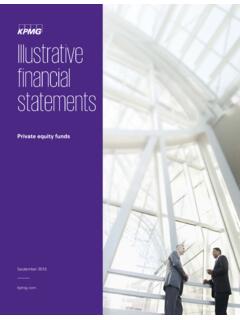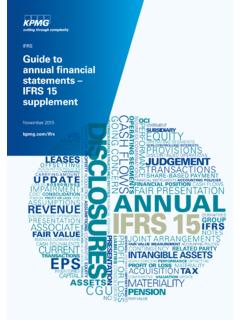Transcription of Moving to the cloud key considerations - home.kpmg
1 Moving to the cloud key considerations Key risk considerations for decision makers February 2016 Executive summaryCloud computing is an established and trusted model for the delivery of IT services in both the public and private sectors. Indeed, cloud should now be the default option considered by public sector buyers of IT products and services as stated in the Cabinet Office principle of cloud First . Similar cloud First principles are also being rapidly adopted by the private sector; we see a variety of FTSE 250 clients looking to move to a predominantly cloud -based IT delivery model over the next 24 months.
2 Organisations now have confidence that cloud offers the cost-effectiveness, agility and security necessary to support the on-going digital transformation common across both public and private sectors. Nevertheless, there remains a lack of awareness of the nature (and associated risks) of cloud computing within senior decision makers within enterprises which can inhibit appropriate adoption of cloud services, potentially jeopardising future competitiveness. This paper outlines the key features and risks of the various forms of cloud computing and provides decision makers with the set of key issues to address when considering the adoption of cloud services.
3 These key issues are shown below: Organisations following this approach should find themselves in a position to be able to operate in a cloud First manner and, more importantly, able to make the most of the undoubted benefits that cloud adoption can offer, cognizant of any relevant considerations to their organisation, in terms of cost-effective agile IT delivery. Contents Introduction 1 The perfect storm: cloud in the UK 2 cloud Adoption key risks and how to mitigate them 4 cloud definitions and security implications 5 cloud Service Providers 9 Commercial and Contractual considerations 12 Privacy considerations 14 The Future 17 The cloud is ready for consumers: Are consumers ready for cloud ?
4 21 Conclusion the 10 key considerations for decision makers 23 Annex A NIST definitions of cloud Computing 26 Annex B key contractual considerations 28 1 Introduction This paper is a short guide for decision makers who are accountable for information risk, and other senior individuals who need to make appropriate, proportionate and risk-aware choices when considering the purchase of cloud computing services for enterprise use. cloud computing is a market that is evolving and expanding rapidly. When thinking about cloud computing there are many non-functional dimensions which should be taken into account, including data protection, data security and data sovereignty.
5 These considerations apply to any form of technology service, but can become more complex in cloud , where the cloud platform may be shared with many other unknown tenants and where customer data may be stored and processed in many different jurisdictions. Despite these complexities, the benefits of cloud can be immense, as cloud can enable organisations to deliver business outcomes and innovation quickly, securely and sustainably with little, if any capital expenditure. There are many different kinds of cloud services, and many different kinds of cloud service providers. This paper helps decision makers choose the right cloud service and service provider for the job, in order to get the optimum benefits from cloud , without compromising the overall security of information assets.
6 2 The perfect storm: cloud in the UK cloud computing is not new As personal consumers most of us have been using cloud for years, even if we were not aware of the fact, services such as Hotmail (now ), Netflix and Skype are all provided from the cloud . What is new, is that cloud is now increasingly being adopted by enterprises keen to exploit cloud s many advantages. cloud comes in many shapes and forms, from shared applications used to manage your HR processes or sales teams through to the capability to build your own virtual infrastructures on shared physical hardware and myriad forms in-between. Enterprises initially displayed a great deal of cynicism about control over their data and services.
7 This not invented here mentality is slowly receding, however we do still meet Chief Information Officer s (CIOs) who see cloud as a threat to their influence and so whom point to poorly defined security concerns as a reason to delay implementation of cloud -based services. Another of the barriers often quoted by those reluctant to adopt cloud services relates to compliance requirements. However, guidance issued by the Information Commissioner s Office1 and (proposed) guidance issued by the Financial Conduct Authority2 make it clear that there are no fundamental reasons why enterprises cannot adopt cloud from the perspectives of those two high-profile authorities.
8 That is not to say that there are no compliance concerns, simply that they require managing alongside other issues rather than being used to prevent progress. 1 For every argument against cloud adoption, there is a counter-argument for cloud adoption, supported by cloud services and cloud service providers that demonstrate that the cloud model has the maturity, breadth and experience to meet the often very diverse needs of the market. cloud services are particularly well-suited to meet the needs of the more agile project and operations delivery methodologies being adopted throughout industry. The efforts of many cloud providers to be transparent about their operations (including obtaining independent assurance certifications) and the increasing number of success stories has steadily eroded the arguments of those resistant to the adoption of the cloud model.
9 Many governments, including the US and the UK, are now actively transitioning to cloud whilst innovative companies across many industries are challenging established players thanks to the agility offered by their chosen cloud providers. cloud is not just for the challengers we do also see some large organisations (including members of the FTSE250) making the wholesale leap into the cloud , with some looking to be able to close their own physical datacentres within a couple of years. However, for over twenty years UK Plc has operated its legacy technology provisioning through a mixed economy of IT Outsourcing, Business Process Outsourcing and, typically in the larger enterprises, in-house provision.
10 Where IT services have been externally sourced, the commercial characteristics have 2 3 tended towards expensive, long term and difficult to break contracts, held with a small, elite group of service providers. This has left many organisations with a skills gap in their retained IT function and overly reliant upon their systems integration partners. cloud offers organisations an alternative model, where IT services are generally sold on a commodity basis. A consuming organisation may only pay for what they use, when they use it, making cloud a highly cost effective model, compared to legacy systems, which are normally built and priced to cope with peak demand.










